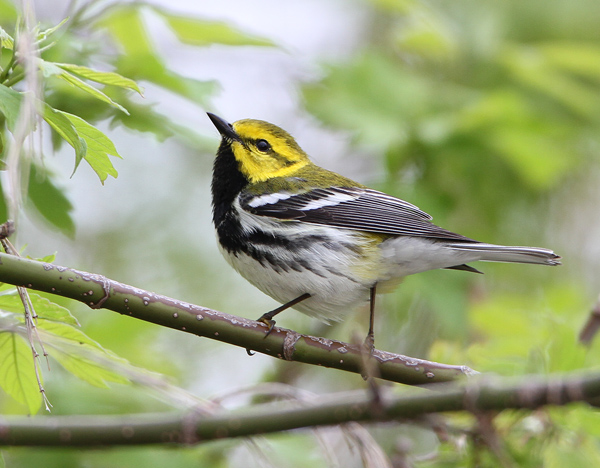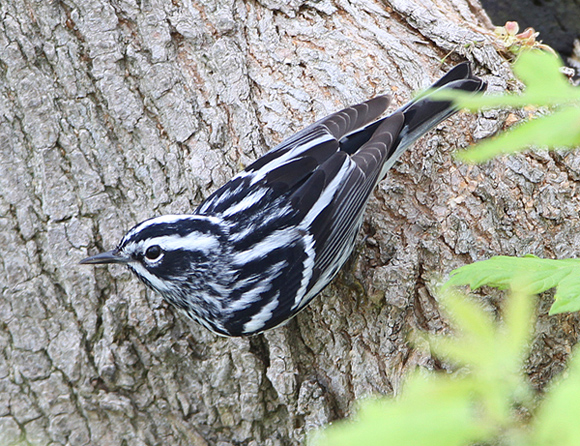Dendroica Farewell: new classification for the American warblers.
Dendroica, we hardly knew ye.
Here in northwest Ohio (Warbler Capital of the World) we have been awash in beautiful, colorful, sprightly American warblers (family Parulidae) for the last several weeks. I’ve been so busy looking at actual birds, and talking to actual birders, that I haven’t kept up with news from the ornithological world, so it was a bit of a shock today when I read this item from the American Ornithologists’ Union (AOU). Just yesterday I was looking at Cape May Warbler, Dendroica tigrina, like the one shown at the top of this post. Today I found out that I’ll never see Dendroica tigrina again.
Because its name has been changed.
We had been hearing rumbles for several years about how the classification of the American warblers was open to some question. Still, for field purposes, it was very useful to think of the genus Dendroica as the most “typical” warblers, the most colorful, flighty, highly patterned ones, and then deal with those other genera that differed somewhat. Well, we can’t do that now, because the genus Dendroica is ceasing to exist.

The artist formerly known as Dendroica: This Black-throated Green Warbler, photographed in northwest Ohio in May 2011, is on its way to a new classification in the genus Setophaga. photo/Kenn Kaufman.
This won’t be “official” until July 2011, when it’s published in the July issue of The Auk, the journal of the AOU. But the Committee on Classification and Nomenclature of the AOU has already published its decision, and the reasons behind it, on its website. So official or not, it’s a done deal, and we might as well get busy getting used to it.
Got your red pen ready? Here’s a brief summary of the new sequence and the new scientific names for the species found north of the Mexican border. Apparently the spelling of the species name will stay the same, and only the name of the genus will change in these cases. (In other words, for example, Cerulean Warbler will change from Dendroica cerulea to Setophaga cerulea.)
Genus Seiurus:
Ovenbird
Genus Helmitheros:
Worm-eating Warbler
Genus Parkesia:
Louisiana Waterthrush and Northern Waterthrush (this change was made official last year)
Genus Vermivora:
Bachman’s, Golden-winged, and Blue-winged warblers
Genus Mniotilta:
Black-and-white Warbler
Genus Protonotaria:
Prothonotary Warbler
Genus Limnothlypis:
Swainson’s Warbler
Genus Oreothlypis:
Crescent-chested, Tennessee, Orange-crowned, Colima, Lucy’s, Nashville, and Virginia’s warblers – this change was made official (moving Crescent-chested from genus Parula, and the others from genus Vermivora) last year, but this sequence of species within the genus is new.
Genus Oporornis:
Connecticut Warbler
Genus Geothlypis:
now includes Gray-crowned Yellowthroat; MacGillivray’s, Mourning, and Kentucky warblers; and Common Yellowthroat – in that order. The three in the middle were formerly in Oporornis.
Genus Setophaga:
Major change here. Formerly this genus included only the American Redstart. Now it includes Hooded Warbler, American Redstart, two species from the genus Parula, and everything that used to be in the genus Dendroica. The sequence of species is supposed to reflect something about the degree to which these things are related, going from the most primitive to the most highly evolved species, so check out this new sequence:
Hooded, Am. Redstart, Kirtland’s, Cape May, Cerulean, Northern Parula, Tropical Parula, Magnolia, Bay-breasted, Blackburnian, Yellow, Chestnut-sided, Blackpoll, Black-throated Blue, Palm, Pine, Yellow-rumped, Yellow-throated, Prairie, Grace’s, Black-throated Gray, Townsend’s, Hermit, Golden-cheeked, Black-throated Green.
Genus Basileuterus:
Fan-tailed Warbler is moved into this genus, and Rufous-capped and Golden-crowned Warblers are still here, in that order.
Genus Cardellina:
Canada Warbler, Wilson’s Warbler, Red-faced Warbler. The first two were formerly in the genus Wilsonia (with the Hooded Warbler, now moved up the chain); Red-faced Warbler had been the only member of this genus.
Genus Myioborus:
Painted Redstart and Slate-throated Redstart
Missing in action: Yellow-breasted Chat. We don’t know what it is, but we’re pretty definite now that it’s not a warbler – and that’s something that any beginning birder could have told you! It’s big enough to eat a real warbler for breakfast, and it has the personality of a thrasher or catbird, even if it does have some yellow on it.
I’m not suggesting that you skip any birding time to write the new scientific names into your field guide. (After all, there’s a very slight chance that the committee might change its collective mind before July.) But if you’ve grown to love the name Dendroica since you started warbler-watching, this heads-up may help you to start the long process of saying goodbye and getting over it. And if you haven’t – well, it’s still fascinating to see how our knowledge of these birds continues to develop. Hooded Warbler related to Redstart! Who would’ve guessed?


Thank you for bringing this to the fore Kenn.
I understand the term “highly evolved” is widespread in usage, but it is inaccurate and misrepresents the actual evolutionary story. The sequence is based on the divisions in their phylogenetic tree, as illustrated here https://jboyd.net/Taxo/List30.html in the “Parulini” tree. Convention is to list the smaller group first at each division. But, it would also be accurate to place the Hooded Warbler at the end of the Setophaga list, it’s just placed first because that clade is one species whereas its sister clade is 33 species. This also highlights why the Hooded Warbler is no more closely related to the American Redstart than it is to any of the other 32 species in that group. It is arbitrary where to place the genus name as long as we have monophyletic genera, so we could retain Dendroica, Parula (including Kirtland’s, Cape May, and Cerulean), and Wilsonia and Setophaga as monotypic as shown in the jboyd link. The phylogenetic tree (while always subject to more testing) represents the actual procession of genetic material over the past 10s of millions of years, whereas the sequence we list the species in and at which nodes we assign the names are arbitrary.
Actually, to do so we would need a new genus name for the Elfin-woods Warbler and it’s close relatives. As is, a name doesn’t exist, so they must all be merged into Dendroica.
Personally, I don’t think most of what is going to be subsumed is “distinctive enough to warrant keeping several genera, especially since I don’t think the contents of the Parula under J Boyd’s delimitation is very useful.
I don believable…
Just last year I made the connection between the epitaph “wood warbler” and the latinized “dendroica”. I should have read more about Linneaus before… NOW IT MEANS NOTHING!?!?!?!
I’d like to read more about this, but I can’t find it on the AOU website. Could you provide a link please?
https://www.aou.org/committees/nacc/proposals/2010-B.pdf
https://www.aou.org/committees/nacc/proposals/2010_B_votes_web.php
So the genus, Vemivora, which in Latin means Worm-eating, no longer contains
the Worm-eating Warbler!
My mind is boggled. JoeRoller, Denver
I found it odd that no one voting mentioned that Northern and Tropical “Parulas” will now be in genus Setophaga and thus perhaps deserving of new English names. (Might be a good idea anyway, since the range of pronunciations I’ve encountered for English “Parula” is bewildering.) The other two warblers in genus Parula don’t have “Parula” English names.
I found it odd that no one voting mentioned that Northern and Tropical “Parulas” will now be in genus Setophaga and thus perhaps deserving of new English names. (Might be a good idea anyway, since the range of pronunciations I’ve encountered for English “Parula” is bewildering.) The other two warblers in genus Parula don’t have “Parula” English names.
I found it odd that no one voting mentioned that Northern and Tropical “Parulas” will now be in genus Setophaga and thus perhaps deserving of new English names. (Might be a good idea anyway, since the range of pronunciations I’ve encountered for English “Parula” is bewildering.) The other two warblers in genus Parula don’t have “Parula” English names.
Captivating! I am always amazed at the photography as well as the beauty of these birds!
WOWWW! Amazing warbler photos Kenn, real crackers! I am so disappointed to hear of the name change, I have been scouring the cliffs of Fair Isle and Shetland for my dream Dendroica for years and indeed my post yesterday on my recent trip to Canada describes my meetings with Dendroica’s . . . .at least it’s not official until July so still ‘valid’. I think i’ll still stick with Dendroica for as long as I can get away with it. . . . .it might take me longer to remember the new changes that it will be find my own ‘Dendroica’ – there got it in again!
These are very nice up close bird photos. I would suggest submitting them to some bird magazines for recognition